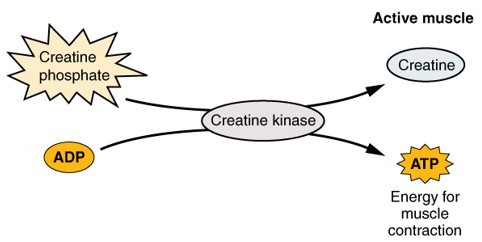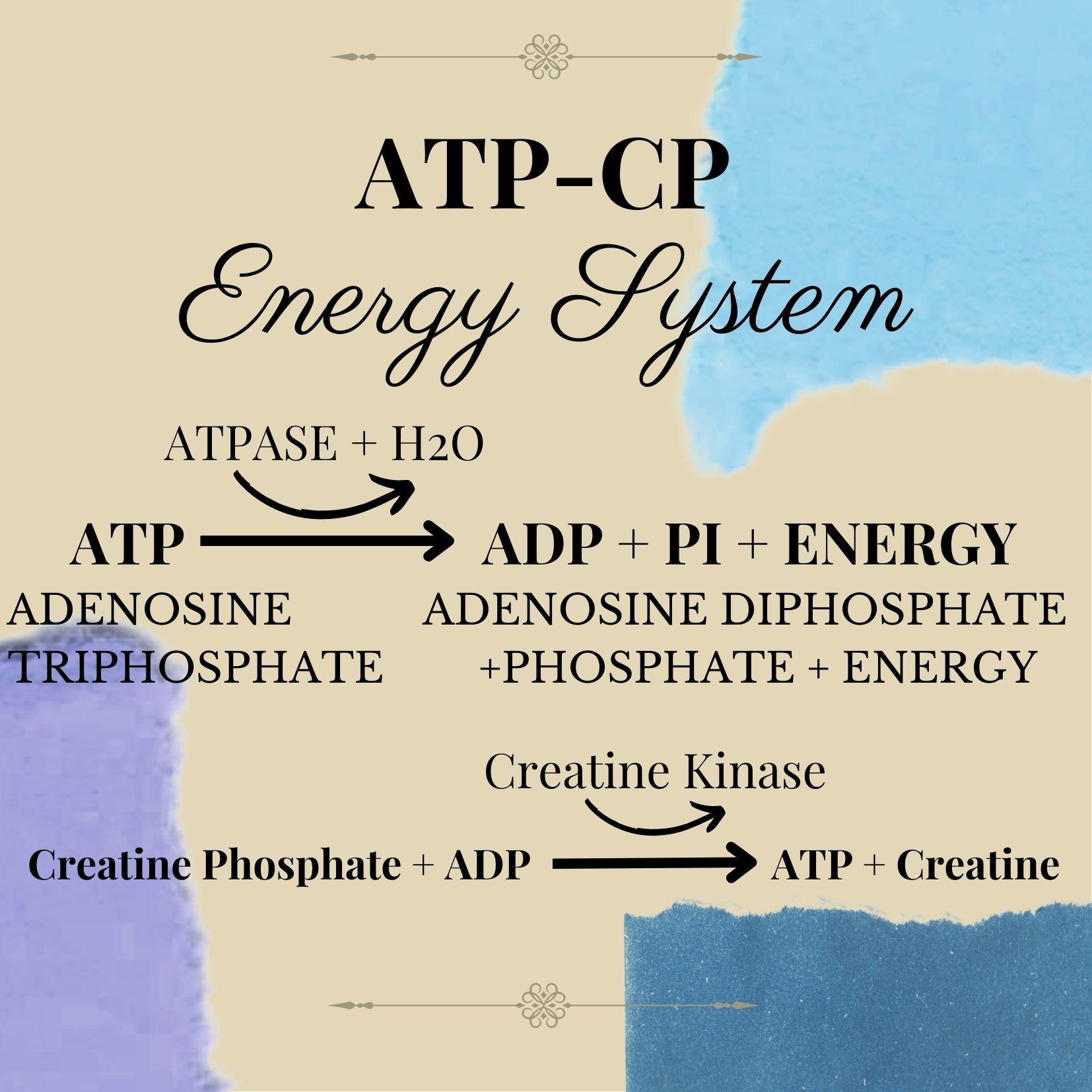8.3 Phosphagen System (ATP-CP System)
The ATP–CP system (also known as the Phosphagen system or the ATP-PCr system) is the least complex of the three major energy producing systems and uses creatine phosphate (CP) as the fuel for ATP production. In general, the less complex the system, the fewer chemical reactions must take place so ATP can be produced faster. However, these quick reactions are not the most energy efficient so the fewer ATP will be produced per unit of fuel. Since this system is the least complex, it is also the fastest and most immediate but provides the least amount of ATP. CP is created when the creatine you eat or synthesize is transported to your muscle tissue and phosphorylated in the muscle. This is how your muscles store phosphate that can be used to rapidly rephosphorylate ADP to ATP. CP is sometimes referred to as phosphocreatine (PCr).
Figure 8.7 ATP-CP System

As seen in Figure 8.7, the ATP–CP system is a one-step chemical reaction where CP is broken down into creatine and inorganic phosphate (Pi). The Pi is transferred to an ADP to rephosphorylate the ADP to ATP. This reaction is catalyzed by the enzyme creatine kinase (CK). The ADP in this reaction comes from the energy producing reaction when ATP is converted to ADP. During the first few seconds of any type of exercise or when exercise intensity increases, ATP levels in the muscle will decline and ADP levels will increase. This increase in ADP signals the cells that there is an ATP (energy) deficit which, in turn, stimulates the activity of CK. As a result, the ATP–CP reaction proceeds faster, and more ATP is produced. This is an anaerobic reaction because it does not require oxygen. Each molecule of CP can generate one molecule of ATP, so the ratio of energy produced per unit of fuel is 1:1.
Figure 8.8 ATP-CP System Summary

Because it is able to rapidly replenish ATP, the ATP–CP system is the predominating energy system during very high-intensity exercise. There is a limited amount of CP stored in the muscles and when CP stores become depleted to low levels, fatigue sets in. During high intensity exercise, CP stores drop below the threshold for fatigue in approximately 5-10 seconds. This depends on the intensity of the exercise (how fast CP is being used) and initial muscle CP stores. Individuals with higher baseline levels of CP may be able to rely on the ATP-CP system for closer to 10 seconds while those with lower levels of baseline CP may fatigue closer to 5 seconds.
The types of activities that rely on this system for ATP production are therefore high to maximal intensity and very short duration (up to 10 seconds). These can be referred to as power activities and include sports or activities such as:
- Throwing (shot put, discus)
- Jumping (long jump, high jump, jumping up to grab a rebound or head the ball in soccer)
- Short, fast sprints (60 – 100 meter dash, stealing a base in baseball or softball)
- Lifting (Olympic lifting, squat (max, near max), lifting a heavy object from the floor to a table)
As you can see, all of these activities require a short burst of explosive power or a very high intensity effort sustained over several seconds. A single bout of very high intensity or maximal work can temporarily drop creatine to very low levels which leads to fatigue of the ATP-CP system. However, during recovery between sets, some of the creatine can be “recycled” and rephosphorylated back into CP. This rephosphorylation of CP takes between 1-2 minutes and allows athletes to train at high intensities multiple times in one training session. The rephosphorylation of CP requires oxygen and research has suggested that individuals with greater aerobic fitness may be able to rephosphorylate CP more effectively (7). This highlights the importance of rest periods during high intensity “power” training and benefits of aerobic fitness for individuals who primarily train or compete in power events. However, not all of the creatine is recycled between sets, with each repetition some is metabolized into creatinine and eventually excreted in the urine. So over time, during a training session, creatine stores get progressively lower until at some point performance will deteriorate due to fatigue.
Media Attributions
- ATP-CP system © OpenStax is licensed under a CC BY (Attribution) license
- ATP-CP Energy System © Natalie Fox is licensed under a CC BY (Attribution) license
